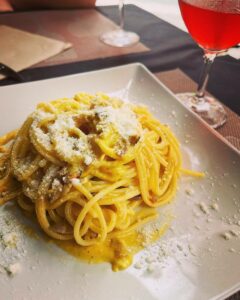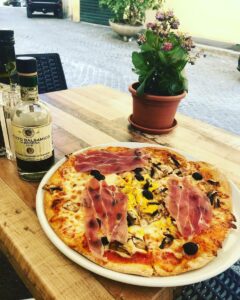
Italian philosophy of life in contrasts (p. 2): Roman Gastronomy
Art of Eating: Roman Gastronomy
Barely immersing yourself in the unfamiliar atmosphere of dolce vita, you feel the need to replenish your energy before continuing the journey.
Imagine how your acquaintance began with Rome, this mysterious Eternal City. After the first day of traveling, in the evening, you leisurely stroll through narrow streets in search of the perfect place to taste the local cuisine. You wander through neighborhoods, noticing authentic establishments, each with its own story. Images of the host or hostess preparing meals for guests come to mind. Each dish is a blend of family traditions, love, a passion for culinary arts, and a unique recipe passed down from generation to generation. It seems that in every establishment, there is excellent food, delicious wine, and impeccable service.
Having made a challenging choice, you sit in a cozy restaurant at a table with pristine tablecloths, lace napkins, a basket of freshly baked bread, and a glass of aged red wine. But here’s the question, what should you order from the menu?
- Spaghetti alla CarbonaraThe history of Italian gastronomy spans more than two thousand years, and one of its most significant discoveries is pasta 🍝.
“La vita è una combinazione di magia e pasta” (Federico Fellini)
Spaghetti alla Carbonara is a hearty dish made with pasta, guanciale (pork cheek), egg yolks, Roman Pecorino cheese, and black pepper. It’s important to note that the classic recipe does not include cream!

There is a version that suggests the name and recipe originated from the Roman Carbonari (coal miners), who would spend months in the forests, cutting down trees to make charcoal. They brought with them calorie-rich, long-lasting food including cured pork, hard cheese, and pasta.
- Pizza alla Romana
Roman pizza is exceptionally delicious, distinct from other types of pizzas in Italy 🍕. Its base is super-thin and crispy crust, browned in a wood-fired oven. The topping can vary, but the classic Roman pizza features tomatoes, mozzarella, anchovies, and oil.

- Salt’ im bocca!
Translated directly, the name means “jump into the mouth,” as no one can resist marinated veal wrapped in Prosciutto (cured ham) 🥩. The veal and Prosciutto, along with sage leaves, are first fried for a couple of minutes in olive oil and then simmered in red wine. The dish is often served with a side of lettuce, tomatoes, olives, or oven-roasted potato wedges.
These dishes represent just a small part of authentic Roman cuisine, which differs from the kitchens of other regions in Italy. The elusive magic of the cooking process, the combination of ingredients, unique recipes, the cult of food, the aesthetics of the establishments, and a love for gastronomic traditions are some of the components of the formula and philosophy of a happy life for every Italian.
Let’s go “from tourism to lifestyle”.









